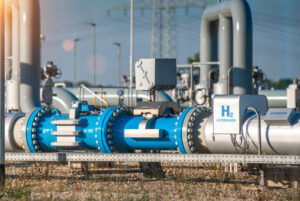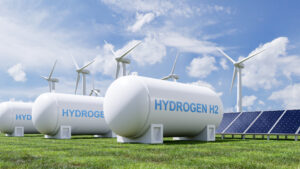
Hydrogen Fuel Generation, Distribution & Usage: What You Need to Know
Hydrogen possesses many potential applications in the shift towards renewable, low-carbon energy.
Hydrogen is gaining popularity as a fuel source due to its clean and renewable properties, offering a promising alternative to traditional fossil fuels.
In this article, we will break down some key insights about hydrogen, encompassing its generation, distribution and beyond. We’ll examine prominent hydrogen initiatives in both Australia and North America, while also delving into some of the collaborative efforts expected to yield innovative solutions on the horizon.

How is Hydrogen Fuel Generated?
The methods for hydrogen generation can greatly vary, resulting in variable costs and environmental impacts depending on these differences.
The U.S. Department of Energy (DOE) identifies that “the primary challenge for hydrogen production is reducing the cost of production technologies to make the resulting hydrogen cost competitive with conventional transportation fuels”.
Some of the pathways to produce hydrogen include:
- Natural gas reforming, which is a relatively cheap production method where a synthesis gas is created by reacting natural gas with high-temperature steam
- Gasification, which uses the reaction of coal with high-temperature steam and oxygen in a pressurized gasifier
- Biomass, which can be used in several forms such as liquids (renewable ethanol), solids (used in a similar manner of gasification as coal) or through microbial conversion via fermentation
- Electrolysis, which uses an electrical current to split water into hydrogen and oxygen

The environmental impacts from the generation of hydrogen vary based on several factors, such as:
- The method used to generate hydrogen
- Any carbon capture or storage incorporated into the production processes to reduce carbon dioxide emissions
- The sources of energy used to create hydrogen, for example where renewable energy is utilized for the electrolysis method
- The water sources utilized for hydrogen creation which could draw from drinking water sources or other sources such as recycled water or rainwater
How is Hydrogen Fuel Distributed?
Why can’t hydrogen simply replace natural gas within the existing infrastructure or be bottled and distributed like liquified petroleum gas?
Hydrogen contains less energy per volume than other fuels, which adds costs to any form of storage, transportation or distribution. Hydrogen also has unique properties that present additional challenges for distribution designs and the suitability of materials. Nevertheless, with its ability to be generated from a wide array of methods, localized and regional production emerges as a feasible option.
The blending of natural gas and hydrogen has and continues to be, a viable way to incorporate hydrogen into decarbonization efforts. For hydrogen to be considered a more viable energy source globally, the ability to transport via existing natural gas infrastructure is a key milestone.
Hydrogen can be distributed via pipelines, however not all existing infrastructure is compatible with hydrogen.

Several pilot projects are currently underway that involve the mixing of natural gas with varying amounts of hydrogen to test infrastructure materials and appliance performance. There are many challenges with hydrogen due to the size of the molecules which can embrittle solid metals and result in cracking of the materials. The compatibility of hydrogen on plastic piping materials and elastomeric seals along with other pipeline equipment and storage containment units is also being evaluated.
Hydrogen can also be transported at high pressures via traditional means like trucks, ships and rail, but a more efficient method is transporting it as a liquid. Cryogenic liquefaction is where hydrogen is cooled to a temperature where it becomes a liquid, however, this method is more expensive and presents additional challenges.
How is Hydrogen Fuel Used?
Hydrogen possesses many potential applications in the shift towards renewable, low-carbon energy. Its use can provide carbon-free heat for cooking and space heating, while also serving as a fuel for diverse industrial processes. Moreover, hydrogen fuel cells offer an efficient means of electricity generation, while its ability to store energy enhances its versatility even further.
Hydrogen Fuel Use in North America
Hydrogen’s role in shaping North America’s sustainable energy future is gaining significant traction, as evidenced by recent groundbreaking projects across the region. These initiatives underscore the commitment of both the U.S. and Canada to advance hydrogen technologies and infrastructure, marking a pivotal moment in the transition towards a cleaner energy landscape.
In the U.S., considerable progress is underway to expand hydrogen utilization across diverse sectors. A notable endeavor involves funding by the DOE towards the development of seven regional hydrogen hubs strategically positioned throughout the country. These hubs serve as pivotal centers for hydrogen production, storage and distribution, facilitating its integration into transportation, power generation, industrial processes and residential and commercial heating applications.
Moreover, the U.S. is witnessing a surge in investments in hydrogen production equipment projects. Businesses spanning various industries are leveraging tax incentives and government support to embrace green hydrogen production technologies, aligning with the nation’s ambitious clean energy objectives.
Canada, on the other hand, is a leader in clean hydrogen production, boasting the world’s largest facility dedicated to producing this versatile energy carrier. Recent initiatives in Canada focus on scaling up hydrogen production capacity and enhancing storage capabilities to meet growing demand, with a particular emphasis on utilizing renewable energy resources to produce green hydrogen.
Furthermore, innovative projects in Canada are driving advancements in hydrogen utilization across multiple sectors, including transportation, power generation and industrial processes, as well as residential and commercial heating. Collaboration between government, industry and research institutions underscores Canada’s commitment to leading the charge in advancing a hydrogen economy.
These collective efforts in both the U.S. and Canada reflect a shared commitment to harnessing the potential of hydrogen as a clean, efficient and versatile energy carrier. By investing in infrastructure, fostering innovation and promoting collaboration, North America is laying the groundwork for the widespread adoption of hydrogen technologies, driving sustainable economic growth, and environmental stewardship for future generations.
Hydrogen Fuel Use in Australia
The adoption of hydrogen in transportation has been gaining momentum in Australia. As a vehicle fuel, hydrogen offers distinct advantages over electric vehicles, including rapid refueling, greater storage capacities and lighter energy storage, allowing vehicles to cover longer distances. These attributes provide significant benefits, particularly for freight transport.
Canberra was the first Australian city to pilot a publicly available hydrogen refueling, which uses water and energy from the existing infrastructure to create hydrogen. There is also a commercial hydrogen refueling station in Port Kembla that was built for heavy vehicles, which utilizes natural gas and biomethane (when available) to create hydrogen at a nearby plant.
Western Sydney also has a hydrogen pilot production facility that creates hydrogen via a 500kW on-site electrolyzer powered by the electricity grid. The hydrogen generated from this facility is blended with natural gas and used across homes and businesses in the area. Excess hydrogen can also be stored and used to create electricity as a backup for the grid or supplied to hydrogen fuel-cell electric vehicles.

Although the energy used to create hydrogen in these facilities is drawn from the electrical grid, these facilities can draw electricity from renewable sources such as solar energy.
Australia has over five million homes that use natural gas for cooking, water and space heating. The blending of hydrogen with natural gas at a level of 10 to 20 percent will be the first step in the transition away from natural gas. Although most appliances and equipment are designed for natural gas use, there are some space heaters, water heaters, cooktops, barbeques, and even gas meters, which have been designed to operate with hydrogen blends and can be converted to operate with 100 percent hydrogen.
There are also Australian companies looking to utilize hydrogen as a suitable fuel for aviation and are preparing for a maiden flight in 2024.
Advancing Building Safety Standards in the Era of Hydrogen Fuel Integration
As global communities forge ahead with their hydrogen strategies, regulatory bodies are diligently crafting safety solutions to ensure the seamless integration of hydrogen-enriched natural gas into various applications.
The International Code Council is pivotal in developing safety standards and requirements that are crucial for regulating the burgeoning hydrogen industry within the built environment. These standards encompass a wide array of appliances, equipment and components, including pipe materials, fittings, valves, gauges, flanges and other engineered elements.
The International Code Council is at the forefront of this effort, actively collaborating with esteemed organizations such as the Canadian Standards Association (CSA), the American Society for Testing and Materials (ASTM) and the National Fire Protection Association (NFPA). Together, these organizations are developing and revising approximately 60 standards to govern hydrogen use with natural gas.
One notable undertaking by the International Code Council is the formation of a dedicated working group tasked with assessing existing building code requirements related to hydrogen admixtures and utilization. Their recommendations, aimed at enhancing safety measures, have been submitted for consideration in the upcoming 2027 editions of the International Fuel Gas Code® and International Fire Code®.
While existing codes and standards provide regulatory guidance for gaseous hydrogen at 95 percent or higher, the combination of natural gas and hydrogen presents unique challenges that are not addressed in current regulatory requirements. Factors such as moisture exposure, leakage potential and combustion properties necessitate careful consideration to determine optimal blending levels that achieve decarbonization goals while ensuring the proper functionality of appliances and piping systems. Amidst the ongoing energy transition, there is a concerted effort amongst regulatory bodies to future-proof appliances, enabling them to operate seamlessly with both natural gas and hydrogen admixtures. To this end, new test gases are being proposed, with a maximum of 20 percent hydrogen admixture suggested for peak performance of materials and appliances.
The International Code Council is a member of the American Institute of Chemical Engineers (AICHE), Center for Hydrogen Safety, enabling ongoing collaboration with experts in the hydrogen industry. This partnership facilitates the resolution of various codes and standards challenges inherent in hydrogen projects, addressing safety concerns, embracing new technological advancements, and integrating their safety features for future advancements.
International Collaboration to Deploy Hydrogen Fuel Strategies and Roadmaps
The International Code Council, along with other key stakeholders from manufacturing, academia, national laboratories and others, are working within the U.S. and Canada to assist in the development and deployment of hydrogen strategies and roadmaps for the safe production, transmission, storage and end use of hydrogen.

The U.S. DOE’s funding of the construction of seven U.S. clean hydrogen hubs, as previously stated, are anticipated to collectively produce up to three million metric tons of hydrogen annually.
In Canada, government-led organizations are currently reviewing feedback from stakeholders for their hydrogen deployment strategy. As the two countries continue to revise their roadmaps and strategies for hydrogen deployment, one thing is clear: they are both committed to decarbonization.
In Australia, the International Code Council is facilitating collaboration with industry experts to promote international collaboration and develop global building safety solutions.
As technology advances and becomes increasingly efficient, thereby reducing the cost and improving the methods of hydrogen production, the International Code Council remains committed to supporting these efforts, which includes advocating for the international harmonization of standards and requirements for the safe use of hydrogen in the built environment.
The Code Council’s PMG team has launched a bimonthly newsletter that covers the latest news in plumbing, mechanical, fuel gas, swimming pool & spa, and more in the U.S. and abroad. Click here or scan the QR code below to subscribe.










